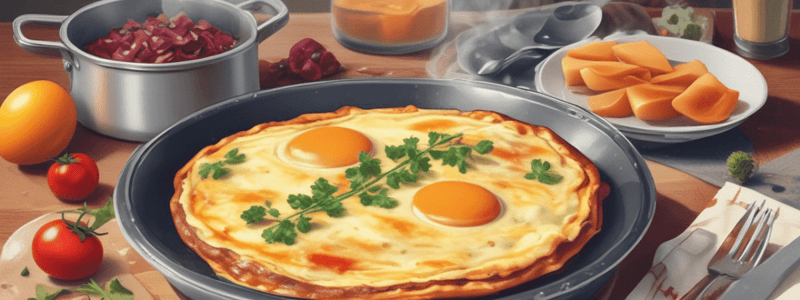Podcast
Questions and Answers
What is the difference between an omelet and an omelette?
What is the difference between an omelet and an omelette?
- Ingredients used
- Spelling and cooking style (correct)
- Cooking time
- Type of pan used
A traditional French omelette is folded in half.
A traditional French omelette is folded in half.
False (B)
What is the ideal texture of an omelette?
What is the ideal texture of an omelette?
Barely set, with the omelette wobbling slightly when shaken.
Before adding vegetables to an omelette, it's common to ___________________ them.
Before adding vegetables to an omelette, it's common to ___________________ them.
What is a typical French filling for an omelette?
What is a typical French filling for an omelette?
It's recommended to overcook an omelette to ensure it's not slimy.
It's recommended to overcook an omelette to ensure it's not slimy.
Match the following fillings with their description:
Match the following fillings with their description:
Why is it recommended to sauté onions, peppers, and mushrooms before adding them to an omelette?
Why is it recommended to sauté onions, peppers, and mushrooms before adding them to an omelette?
What is the ideal diameter of a nonstick sauté pan for cooking an omelette?
What is the ideal diameter of a nonstick sauté pan for cooking an omelette?
You should always add fillings to an omelette.
You should always add fillings to an omelette.
What is the purpose of whisking the eggs vigorously?
What is the purpose of whisking the eggs vigorously?
You can use a heat-resistant ____________ spatula to avoid melting or damaging the pan's nonstick coating.
You can use a heat-resistant ____________ spatula to avoid melting or damaging the pan's nonstick coating.
What is a good way to use up leftovers?
What is a good way to use up leftovers?
You should overfill the omelette with fillings.
You should overfill the omelette with fillings.
Match the following ingredients with their typical usage in an omelette:
Match the following ingredients with their typical usage in an omelette:
What should you do when the bottom of the eggs starts to set but not brown?
What should you do when the bottom of the eggs starts to set but not brown?
What is a characteristic of adding uncooked vegetables to an omelette?
What is a characteristic of adding uncooked vegetables to an omelette?
Masala omelettes are a gourmet dish by any chef's standards.
Masala omelettes are a gourmet dish by any chef's standards.
What is the key to flipping an omelette?
What is the key to flipping an omelette?
To make fluffy omelettes, one way is to ____________________ air into the eggs.
To make fluffy omelettes, one way is to ____________________ air into the eggs.
What happens when you cook an omelette in a pan that is too large for the number of eggs used?
What happens when you cook an omelette in a pan that is too large for the number of eggs used?
Match the types of omelettes with their characteristics:
Match the types of omelettes with their characteristics:
Adding too much food to a small pan always results in a fluffier omelette.
Adding too much food to a small pan always results in a fluffier omelette.
Omelettes can be served in a variety of ways similar to ____________________ eggs.
Omelettes can be served in a variety of ways similar to ____________________ eggs.
Flashcards are hidden until you start studying
Study Notes
Cooking Omelettes
- To cook an omelette, crack eggs into a bowl, beat them until light yellow, and add salt, pepper, and a splash of milk.
- Heat a nonstick sauté pan over medium-low heat, melt butter, and pour in the eggs.
- Let the eggs cook for about a minute, until the bottom starts to set, then gently push the edges into the center to allow the liquid egg to flow underneath.
- Continue cooking until no more liquid egg is present.
Flipping Omelettes
- Use a heat-resistant rubber spatula to loosen the omelette if it sticks to the pan.
- Gently flip the omelette over, helping it along with the spatula if needed.
- Cook for a few more seconds until there are no more raw eggs.
Adding Fillings
- Add mushrooms, cheese, fresh herbs, or other fillings in a straight line across the center of the egg.
- Fold the omelette over the filling, lining up the edges.
Tips and Variations
- Use a nonstick pan with a diameter of 6-10 inches and a heat-resistant silicone spatula.
- Don't overfill the omelette or it will break.
- Add leftovers to the omelette for a quick and tasty meal.
- Omelettes can be served with bread, grilled tomatoes, or as a filling in sandwiches and wraps.
Types of Omelettes
- French omelette: folded, with a basic cheese and herb mixture
- Indian Masala Omelette: greasy, frilly, and powerful, with finely sliced onions, tomatoes, chilies, and coriander
Troubleshooting
- Whisking air into the eggs can help make fluffy omelettes.
- Cooking in a pan that is too large for the number of eggs used can result in a flat omelette.
- Putting too much food in a small pan can result in a rubbery omelette.
Studying That Suits You
Use AI to generate personalized quizzes and flashcards to suit your learning preferences.


